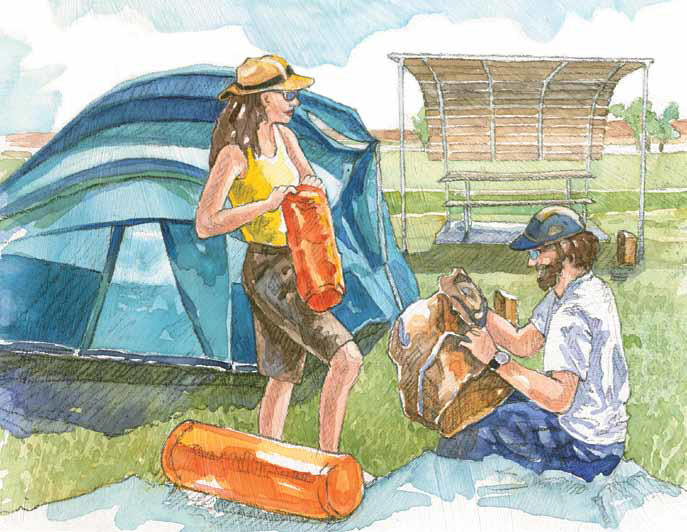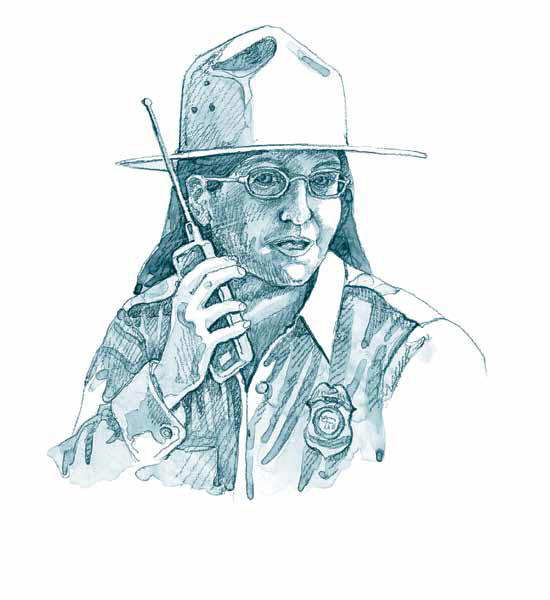
Adventures with the Parkers
Teacher’s Guide
Each book in the exciting Adventures with the Parkers series for kids 8–13 explores a popular national park and is packed with adventure, as well as engaging and educational facts about nature, outdoor safety, and much more. Vacation has never been this fun!
This Teacher’s Guide is meant to give direction to teachers who want to use the Adventures with the Parkers books as part of their curriculum.
For information on School and Library Sales Orders, contact:
Globe Pequot Press
128 Pinnacle Drive
Springfield, TN 37172
(800) 243-0495; fax (800) 820-2329
cynthia.robbins@globepequot.com or info@globepequot.com
Series List
Arches and Canyonlands National Parks: In the Land of Standing
Rocks
Bryce Canyon and Zion National Parks: Danger in the Narrows
Glacier National Park: Going to the Sun
Grand Canyon National Park: Tail of the Scorpion
Great Smoky Mountains National Park: Ridge Runner Rescue
Mount Rushmore, Badlands, Wind Cave: Going Underground
Olympic National Park: Touch of the Tide Pool, Crack of the
Glacier
Rocky Mountain National Park: Peril on Longs Peak
Yellowstone National Park: Eye of the Grizzly
Yosemite National Park: Harrowing Ascent of Half Dome
®1
Historical Timelines
The Parkers often reflect upon or even “meet up” with famous historical characters within their national park adventures. In the Land of Standing Rocks features John Wesley Powell. Ridge Runner Rescue features the Walker Sisters. Harrowing Ascent of Half Dome is often referring to John Muir. Throughout the Parkers series you will find such references.
• Choose ten events on specific dates that highlight your park’s human history and historical characters.
• Collect pictures, research details, and find unique stories related to each event.
• Once all the information is gathered convert it into a classroom poster–sized timeline. You can even use computer graphic technology!
• Make sure to record each event in chronological order.
• Highlight each event with an accompanying picture and brief paragraph of information about the event.
• Include within the ten events: the date when the park was first discovered, who the key early explorers were, and when it became a national park.
• Give the timeline an interesting and catchy title. For example, “Yosemite’s Colorful Past.”
• Be sure to choose what you think are the most important events in the park’s history.

Text © 2012 by Mike Graf, Illustrations © Marjorie Leggitt
®2
Historical Interviews
In each of the Parkers books there are key historical figures covered such as: the Walker Sisters, John Muir, George Grinnell, John Wesley Powell, Gutzon Borglum, Ebenezer Bryce, and so on. These historical figures allow us to connect to the parks on a human level. That is to say that they help us to understand what it was like to live in the parks during a specific time.
• Pretend to be one of the park’s key historical figures such as an explorer, pioneer, resident, conservationist, or paleontologist.
• Dress up as this key person and find related props to make your character seem authentic.
• Make a short speech to your classmates regarding your role in the park’s history as well as some colorful events that you were involved in or know of.
• Then, once the speech is over, hold a press conference in front of the group, allowing the audience to ask prepared or impromptu questions about your role and past in the park.

3
In the Parkers’ adventures, many park features are a large part of the story. Long’s Peak plays a prominent role in Peril on Longs Peak. Delicate Arch in In the Land of Standing Rocks; Grinnell Glacier in Going to the Sun; Blue Glacier in
Touch of the Tide Pool, Crack of the Glacier; the Narrows and Queen’s Garden in Danger in the Narrows; and Half Dome in Harrowing Ascent of Half Dome are also key examples.• Use the recipe below to make several models of your park’s key natural features such as a mountain, canyon, hot pool, dome, or glacier. When dry, paint appropriately.
2 c. flour
1 c. salt
4 tsp. cream of tartar
2 tbsp. salad oil
2 c. water (with food coloring added, optional)
Mix the ingredients together in a pan. With adult supervision cook over low heat and stir until the mixture becomes a ball. Remove from heat then let cool thoroughly. Once cool, knead the clay mixture until smooth. Keep clay in an airtight container until you are ready to model.

Text © 2012 by Mike Graf, Illustrations © Marjorie Leggitt
4
This is a great activity for the Smokies, Tetons, and Olympic with their very diverse forests that the Parkers experience. Peril on Longs Peak also has many references to the forest within the park as do several other books in the series, including Tail of the Scorpion, which has dense forests as well as arid deserts!
• Choose 8–10 key trees of your park and research the unique characteristics of their leaves or needles and cones.
• Find pictures on the Internet, in tree identification books, or in magazines of each of the above features.
• Now create a poster to share your findings. The poster will be divided in two.
• On one half of the poster, attach individual pictures of each of your key trees. Use pictures from the Internet or magazines, or create realistic drawings for each illustration. Create labels to identify each tree. For added interest you can list the tree’s common name(s) as well as scientific name.
• On the other half of the poster, attach with glue or tape a picture flap for each tree’s leaves or needles and cones. Attach the picture so that it will lift as a flap, revealing underneath the name of the tree it belongs to as well as further descriptions of the tree, including detailed characteristics of the tree’s leaves or needles and cones, habitat, size, and descriptions of its bark and nuts or seeds, if any.
• Display your poster in class and let others try to match the tree with its leaves or needles and cones.

Text © 2012 by Mike Graf, Illustrations © Marjorie Leggitt
5
Morgan, James, and their parents are always on the lookout for large animals within each park. Several of the Parkers books feature large mammals; these titles include
Going to the Sun, Eye of the Grizzly, Peril on Longs Peak, and Going Underground.• Choose a park from the Parkers series and research to find out which animals live there.
• Make a list of the 8–10 key, often viewed animals, at your park.
• Get information from the Internet on their diets, habitats, sizes, weights, and prints.
• Now make a poster display. On one half of the poster, put pictures of the animals with their names, heights, weights, and habitats, and any other information that you would like to include.
• On the other half of the poster, draw or use pictures to display each of the animals’ footprints. Make sure to place them out of order from the pictures already arranged on the other half of the poster. If prints are not drawn to scale, give in numbers the actual size of the prints.
• Underneath each footprint, print the animal’s name and then cover with a flap.
• Invite visitors to guess the print of each animal.

Text © 2012 by Mike Graf, Illustrations © Marjorie Leggitt
6
Weather is always on the Parkers’ minds—as it should be when journeying to a national park. All visitors should know and check weather for their travels and plan and prepare accordingly. Most summer national park visitors can encounter thunderstorms, but high elevation parks such as Rocky Mountain, Glacier, Olympic, the Grand Tetons, Yosemite, and Yellowstone have highly changeable summer weather that could also include sudden, extreme cold. Acadia in Maine also has very changeable weather for summer visitors. Several of the books in the Parkers series feature potentially perilous weather events. Key examples in the series include Peril on Longs Peak, Crack of the Glacier, Harrowing Ascent of Half Dome, Danger in the Narrows, Going Underground, In the Land of Standing Rocks, and Tail of the Scorpion.
• Prepare a park weather broadcast PowerPoint slideshow.
• Gather and save 5-7 weather maps from the Internet that include radar, satellite, and temperatures, among other information, for your park and region.
• Design the maps to include forecasts for precipitation as well as temperatures for the days you are potentially there.
• Add and design additional maps with weather safety features and/or weather at certain parts of the park—such as higher elevations for the visiting time.
• You could also include average expected temperatures and precipitation for the anticipated visiting times. These can be developed using graphs.
• Put your maps in order in a slideshow to develop your presentation. Be sure to include specific information about various popular parts of the park.
• Give your park weather broadcast in front of your family or class, or record it and post it to view on video!

Text © 2012 by Mike Graf, Illustrations © Marjorie Leggitt
7
Travel into the wilderness can pose many safety issues and key areas of concern. The Parkers have encountered several safety-related issues throughout the series. Particularly, dangerous conditions occur in
Peril on Longs Peak, Harrowing Ascent of Half Dome, Danger in the Narrows, Ridge Runner Rescue, Crack of the Glacier, Tail of the Scorpion, Eye of the Grizzly, and more.• Research the various safety concerns of your park.
• Use the park’s website and other Internet sources to start.
• Also try and find out if your park has a search and rescue organization. Can you interview them?
• Then develop with as much information as possible a list of key items in a “survival kit” that would feature your park’s individual safety needs.
• Some items could include: bear pepper spray, ace bandages, ibuprofen, water filters, bandages, flashlights, and rain gear.
• Present these items to your class and others while also relating to the park’s specific safety needs.

Text © 2012 by Mike Graf, Illustrations © Marjorie Leggitt
8
Throughout the series the Parkers learn about concerns and controversies affecting the future of their parks. Night sky pollution, endangered species, overcrowding, global warming, and other areas of concern affect each park in a variety of ways.
• Research and learn five or more problematic events occurring at or near one of the parks.
• Then research and learn ten or more positive events that are occurring, often done to reduce the concerns—such as buses within the parks, outreach programs, wilderness legislation, recycling, and such.
• Now find ten or more recreational activities that can be done in your park: hiking, backpacking, swimming, rock climbing, photography classes, horseback riding, skiing, stargazing, etc.
• Combine the three lists to make a national park gameboard.
• On posterboard make a trail of spaces highlighted by park scenery that leads from one end of the park to another, such as the entrance gate to the top of Longs Peak.
• Write one event in random order from the combined list in each space. Add directions for moving forward, backward, or skipping spaces along the way. For example: “Bear breaks into car due to improper food storage—move back three spaces.” Or: “Recycle all your garbage at park recycling center—move ahead one space.”
• Decorate your board fully with scenes from your park.
• Make pieces/people or player markers to move along the way.
• Make cards or use dice to move markers along the way.
• Invite classmates, friends, or family to play your national park game!

Text © 2012 by Mike Graf, Illustrations © Marjorie Leggitt
9
Often when the Parkers travel to parks, they also go to other parks in the area—Arches/Canyonlands, Badlands/Wind Cave/Mount Rushmore, and Zion/Bryce are three examples. Many real people do the same. Trip itineraries are a great way to follow up after reading a Parkers book (or books!).
• Plan out a two-week trip to one or more of the national parks in the series. Consider bundling the parks of a given region such as Glacier, Yellowstone, and the Tetons.
• Show on a road map the route needed to get to each park by tracing it out.
• Inquire into and plan on places to stay along the way and once in the park. Highlight these on your road map, and then list them on a separate itinerary. Make sure to add your list of contacts with phone numbers and reservation numbers.
• On your itinerary show and list the mileage needed to drive each day along the route from where you live to the park and regions within the park that you will visit.
• Make a potential daily schedule for each day at each park. Include scenery, activities, and trails. These can be derived from national park websites.
• Present your potential two-week vacation to your parents. See if you can convince them to actually go!

© 2012 by Mike Graf, Illustrations © Marjorie Leggitt
10
As the Parkers explore each park, they also learn of the Native American legends and historical explorers related to each park. They also discover many of the stories related to the park’s past history, and key historical figures come to life. Some great history and legends, in and among other parks and people, include: John Wesley Powell in Canyonlands, John Muir in Yosemite, the Walker Sisters in the Smokies, Alvin McDonald in Wind Cave, the Rockefellers in the Tetons and Acadia, and so on . . .
• Find out what historical figures are associated with a Parker national park.
• Learn about what they did for and around the park.
• Acquire or make materials for a presentation using what could be some of their clothes and artifacts.
• Research some famous speech or writing they made, or aspects of several key experiences, and then write your own version of a speech for them.
• Dress up as your famous person in costume and present your speech to your classmates or group.
• Be prepared to answer questions about the famous person after!

Text © 2012 by Mike Graf, Illustrations © Marjorie Leggitt
11
The Parkers experience and learn—through their activities, events, or ranger programs—key current events or issues occurring at national parks. Examples include the condor program at the Grand Canyon, current and ongoing cave exploration at Wind Cave, fossils being found and dig sites set up at Badlands, glacier declassification due to global warming in Glacier, wolf reintroduction and pack numbers in Yellowstone and the Tetons, and monitoring the ongoing mountain goat issues in Olympic.
• Find out what key current events are ongoing at one of the Parkers parks.
• Use the Internet, National Parks Conservation Association, and park websites to research these key critical issues.
• Choose one critical issue and make a full PowerPoint summary of the problem using graphic displays, photographs, and the key points of your research to present.
• Prepare and present a ten-minute speech to your class or group about this issue and what the park and other organizations are doing about it.
• Finish your presentation with a list of some things the general public or park visitors can do to help the park related to the key issue.

Text © 2012 by Mike Graf, Illustrations © Marjorie Leggitt
12
The Parkers, of course, love to camp. And being amongst the elements, weather, and wildlife are constant factors to consider. The family encounters bears in Yosemite, a mountain lion in Canyonlands, flash floods in Zion’s Narrows, hail and thunderstorms in Rocky, and consistent rain in the Smokies.
• Prepare a complete Parkers campsite with all the essentials.
• Include, if possible, sleeping gear, flashlights, cooking items, proper food storage (such as a bear canister), laundry line, and cleaning gear. You might even display a first-aid kit complete with a list of ingredients.
• Also include games, books, and other inclement-weather activities.
• Display your campsite and label the park it is at. Invite your classmates or group to come inside and see how the Parkers “lived” while at the park.

Text © 2012 by Mike Graf, Illustrations © Marjorie Leggitt
13
There are many spectacular natural features that the Parkers view while at each of the national parks. Some prominent ones include: Charlie’s Bunion at the Smokies, the Narrows in Zion, Queen Victoria at Bryce, Half Dome in Yosemite, Blue Glacier in Olympic, Grinnell Glacier in Glacier, Grand Teton in the Tetons, Delicate Arch in Arches, and Longs Peak in Rocky.
• Learn as much as you can about the natural feature of your choice in one of the Parkers’ parks. Specifically learn about how it was created, legends about its creation, when it was first discovered, and how to get to the feature now.
• Create a costume that makes you look like the feature or part of the feature.
• Present yourself as that feature to your classmates.
• Present a speech about what you are, how you were created, and what it is like being such a prominent feature in such a spectacular national park. You may want to bring pictures of the actual formation to present as well.
• After your speech, invite classmates or your group to ask you questions as if you were that natural landmark itself!

Text © 2012 by Mike Graf, Illustrations © Marjorie Leggitt
14
The Parkers, and all park visitors, face serious safety issues while visiting each of the national parks. Some key danger areas that have become part of the Parkers’ adventures include: thermal areas and grizzly bears in Yellowstone, rockfall in Yosemite, lightning in Rocky, fires in Glacier, hypothermia in Olympic, Flash Floods in Zion, ticks in the Smokies, and heat issues in the Grand Canyon.
• Find out 3–4 key safety issues that affect one of the Parkers’ parks.
• Learn all you can about those issues, why they occur, and what visitors can do to be safe while considering these issues.
• Make a poster or PowerPoint slideshow highlighting the park’s main safety concerns. Show where the areas of concern are, and what people can do to assure their and others’ safety while at the park.
• Present your information to your group.

Text © 2012 by Mike Graf, Illustrations © Marjorie Leggitt
15
The Parkers certainly take advantage of the many hiking trails within the parks in the series. Some of the most notable hikes include: the Narrows, Queen’s Garden, Half Dome, Angel’s Landing, Castle Trail, Hoh Rain Forest and Blue Glacier, Longs Peak, Fern/Odessa Lakes, Grinnell Glacier, Sperry Chalet, the AT Trail, Mount Le Conte, Delicate Arch and Devil’s Garden, the Precipice Trail, Teton Crest Trail, and many, many more.
• Make a poster or pamphlet highlighting 5–6 of the key trails within one of the parks.
• Find out the following on each trail: mileage, elevation, elevation gain and loss, difficulty, and the scenery along the way.
• Display your key trails listed by easy, moderate, and difficult within the poster or pamphlet.
• Give any additional information you can find about the trail: weather, location, safety concerns, particular gear needed, and perhaps best time of day to hike.
• Post the information as well as pictures of the scenery you will see while hiking the trail.
• See if you can convince your parents or anyone else to potentially take a hike with you in the future while at that park!

Text © 2012 by Mike Graf, Illustrations © Marjorie Leggitt
16
On many hikes in each of the parks in the Parkers series, the family encounters spectacular wildflower displays. Some particular parks where these magnificent displays of wildflowers occurred include: Hurricane Ridge in the Olympics, in the high mountains of the Tetons, along the AT Trail in the Smokies, throughout Rocky Mountain but particularly along Trail Ridge Road, and in Glacier up at Hidden Lake and along the Sperry Glacier Trail.
• Find out five or more wildflowers that grow at one particular park.
• Learn the habitat they are typically found in and make a card or flyer with that information.
• Then go to your local nursery and see if these flowers are available for purchase. While there learn how to care for them and how long it will take for them to bloom.
• Plant and care for your wildflowers so that they are ready to exhibit.
• Once your flowers are in bloom, present them to your group. Also present the information you gathered on where they are found in the park and their typical growing season.
• Post your displays with each flower’s information. Include in your display a map of where the flowers are found in the park as well as what time of year.

Text © 2012 by Mike Graf, Illustrations © Marjorie Leggitt
17
The Parkers, while exploring in each of their national parks, experience an immense display of geology and natural history. From granite in Yosemite, Acadia, and the Smokies to rhyolite in Yellowstone and sandstone in the Utah parks, there are a lot of rocks out there.
• Find out the five most common rocks found at one of the Parkers’ parks. This information can be garnered through the national park’s website.
• Learn the origins of these five common rocks, how they formed, and where they are now located in the park.
• See if these five types of rocks can be purchased at a local nursery, rock shop, or online. Acquire a small quantity (a few pieces and a small size) of each of the five rocks.
• Glue each of the five rocks on a poster.
• Next to each rock, list information about its origin, weight or density, and hardness. Include any other interesting details. For example, how the rock may have been used by early inhabitants of the region.
• Let visitors test the hardness of the rock or weight and density by having the extra rock samples nearby.
• Finally, tell where each rock is found within the park.

Text © 2012 by Mike Graf, Illustrations © Marjorie Leggitt
18
Morgan and James in the Parkers series are often referring to the national park map, which all visitors receive when entering the park. At times they even journal key events, wildlife viewing, and scenery on the maps. This happens in
Eye of the Grizzly, Ridge Runner Rescue, Peril on Longs Peak, In the Land of Standing Rocks, and more Parkers adventures.• Write to one of the parks in the series and acquire a park map. These can also be accessed by downloading a copy from the park’s website.
• Research ten key scenic attractions at your park by using the “top ten list” at the back of the Parkers book, and information from the park’s website.
• Highlight those locations on the park map.
• Develop a large version/poster-sized park map.
• Locate the key features on the map you have made and give a little information about why this is a “must-see” attraction. Label your poster something like “Must-See Attractions at . . . ”
• Share these must-see attractions with your group or class. You can also enhance the presentation by using actual slides or photographs of each feature gathered from the park’s website.

Text © 2012 by Mike Graf, Illustrations © Marjorie Leggitt